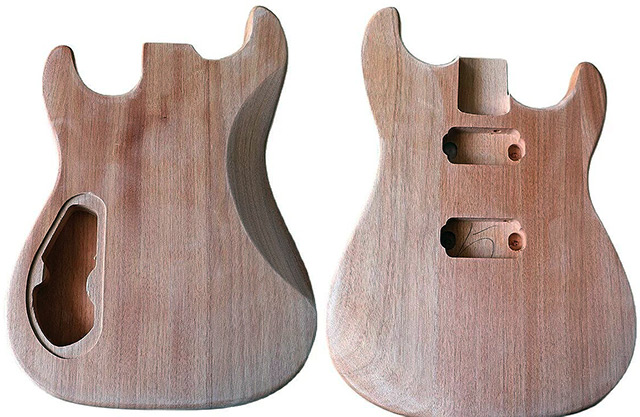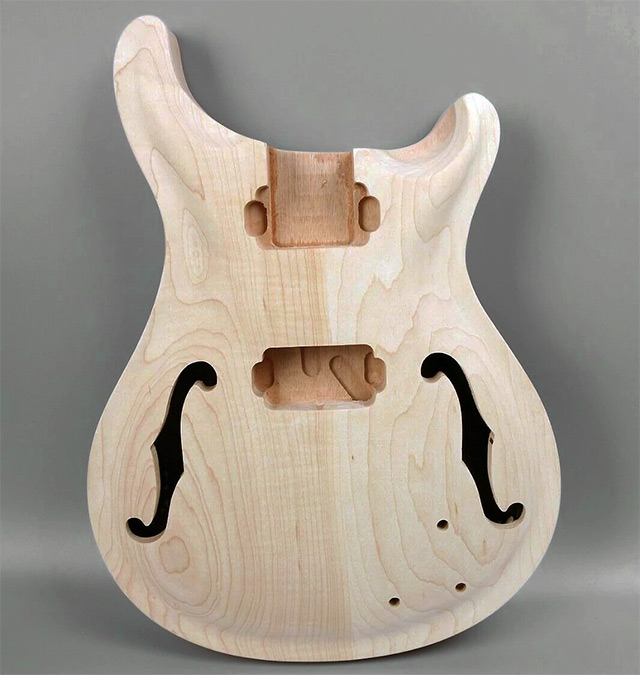Electric guitars are heavy. Anyone who has played the acoustic guitar would say so. While acoustic guitars are much bigger, they feel sort of fragile in your hands, unlike electric guitars that feel so solid and heavy. But is there a reason why they are made that way? We’ll find out in this article!
Electric guitars are heavier because they are typically made of solid wood. A typical electric guitar weighs around six to ten pounds. Besides the solid body, electric guitars also contain electronic components that add additional weight to the guitar.
Why Are Electric Guitars Heavier?
The neck and, consequently, the whole body of the electric guitar is under a lot of tension which is greater than 100 pounds. The tension can be even higher if you’re using higher gauge strings. Acoustic guitars are braced to withstand this tension, whereas electric guitars are typically made of a solid block of wood.
Body is Made of Solid Wood

Most electric guitars are made of solid wood, and unlike acoustic guitars, there is no need for a soundboard or a sound chamber. Electric guitars produce sound by using pickups and amps. The pickups convert the strings’ vibrations into electric signals, which are then sent to the amp that amplifies the signal to produce the sound. One of the other benefits of having a solid body is that the signal stays very clean since the body doesn’t vibrate much or at all from the strings’ vibrational energy. This prevents the pickups from converting the body’s vibration into a signal which may add unwanted feedback.
On the other hand, acoustic guitars depend on the “acoustics” of the guitar, and a differently shaped sound chamber or one made of different materials greatly affects the tone.
The body of a solid–body electric guitar doesn’t affect the tone to a degree anywhere close to an acoustic guitar or at all (we’ll get on to that a bit later).
Mostly hardwoods like mahogany, alder or ash etc., used for solid body guitars, are much heavier than other non–hardwoods. For example, the density of ashwood is around 40 to 43 pounds/cubic foot compared to, for example, a typical pinewood which is 25 pounds/cubic foot.
Inexpensive guitars may be made of other non–hardwoods like pinewood or agathis but are still much heavier than acoustic guitars, which have a fully hollow body and are made of sheets of wood.
Electric guitars also have a different bridge setup than acoustic guitars. The bridge is usually much heavier and made of metal. The solid body to which it is screwed or bolted helps keep it firmly in place.
The fact that electric guitars are made of solid wood is why acoustic guitars, despite being much bigger with considerably deeper bodies, still weigh half that of an electric guitar which looks smaller.
The solid body of the guitar has a small cavity or chamber that houses the electronic components and wiring and is covered by the pickguard.
Metal and Electronic Components Add Weight
The electronic components comprise the pickups, wiring, potentiometers, switch and output jack. Out of all these, pickups are usually the heaviest since they contain magnets and metal parts. All of these combined can weigh around half a pound or more, largely depending on the number of pickups (two or three) and how heavy they are.
The bridge is another component (though not electrical) that weighs a fair bit. Acoustic guitars usually have much lighter bridges compared to electric guitars. Some floating–type vibrato bridges can weigh close to a pound and even more with the whammy bar attached.
Though a matter of great variation, all these add weight to the guitar.
Do All Electric Guitars Have a Solid Body?
Electric guitars vary a lot, and it wouldn’t be fun if this weren’t the case. The reason guitars are so popular is that there are so many variations. And typically, different types of guitars have different tonal properties, sometimes subtle and sometimes very obvious.
One such variation is the body type of the electric guitar. Though most electric guitars are solid–body, some can have chambered, semi–hollow or even fully–hollow bodies. These guitars have a different tone than standard electric guitars and are mostly used in genres such as blues and indie rock.
Chambered Body Guitars
Close to looking like an electric guitar, these have a small chamber in their otherwise solid body to reduce the weight. An example is the Fender Telecaster Thinline which is a Telecaster with a small cavity and an f–hole (similar to violins).
Even though the chamber is not large enough to provide much acoustics, these guitars have a subtly different tone than their non–chambered sibling — the Telecaster. It is also a good pound lighter than the Telecaster.
Semi–Hollow/Fully–Hollow Body Guitars

Both semi–hollow and fully–hollow guitars are referred to simply as semi–acoustic guitars. Both of these guitars look very similar to each other but are considerably larger than electric guitars. Semi–acoustic guitars are made of sheets of wood, much like acoustic guitars, but different from chambered–body guitars that are made of a solid block of wood like electric guitars.
Semi–hollow body guitars have a block of wood added to the center of the sound chamber to reduce some feedback which is one of the issues that almost all semi–acoustic guitars have.
Fully–hollow body guitars, as the name suggests, have a hollow sound chamber and are satisfactorily loud when unplugged. However, both of these guitars can be played unplugged in intimate settings.
Because of their different tonal characteristic, semi–acoustic guitars are not a replacement for electric guitars. These guitars can weigh around 5–8 pounds, similar to electric guitars. Some people use these guitars for their specific sounds in certain genres, while other electric guitarists use them as practice guitars because they sound loud enough unplugged.
Average Weight of Popular Electric Guitars
You can expect a typical acoustic guitar to weigh around 2.5 to 5 pounds. This is much lower than a standard electric guitar, as evident from the list below. The lightest among them — the Parker Fly — among the lightest electric guitars in the world weighs similar to a heavy acoustic. It is made of a combination of various tonewoods and carbon fiber. At the same time, the fretboard is completely made of carbon fiber.
| Guitar | Weight |
|---|---|
| Gibson SG | 6.5 pounds |
| Gibson Les Paul Standard | 8 pounds |
| Fender Stratocaster | 7-8 pounds |
| Fender Telecaster | 7-8 pounds |
| Fender Jazzmaster | 8.5 pounds |
| Ibanez JEM | 8 pounds |
| Yamaha Pacifica | 7 pounds |
| Washburn Parallaxe | 8.5 pounds |
| Epiphone ES (Semi-hollow) | 6 pounds |
| Rickenbacker 350V63 (Semi-hollow) | 7 pounds |
| Gibson SG | 6 pounds |
| Parker Fly (Composite material body) | 4.5 pounds |
Do Tone Woods Matter in Electric Guitars?
In electric guitars, the wood type does not matter much, unlike acoustic guitars, where the size, shape and wood type affect the tone quite clearly. The degree to which the type of wood affects the tone of an electric guitar is a matter of great debate. Some luthiers and people think it does affect the tone due to the characteristically different ways the woods absorb certain frequencies more than others.
While others think it doesn’t affect the tone much to be perceptible or at all. They feel that even if there is a slight difference in how the body affects the strings’ vibration, it gets diminished as it passes through each of the steps of sound production — from the pickups to the electronics and the amp.
My own stance is that type of wood doesn’t matter much. There could certainly be a difference if some people, especially luthiers with so much experience, say so. But for all practical purposes, since electric guitars are played with at least some effects, even if there is a tone difference, it would be negligible to almost non–existent.
Do Heavier Guitars Sound Better?
Again, closely related to the wood choice, some people believe guitars made of denser, heavier wood sound better and have more sustain. Many people would agree that denser wood seems to increase the guitar’s sustain. But, again, it varies so much between guitars you really can’t say that for sure. You would almost certainly find that different bridges affect the sustain much more than anything else (except the sustain effect pedals!).
While I’m no expert in wood types, I would recommend getting a guitar that has a comfortable weight. A heavy guitar can strain your shoulders and back, particularly when you’re not used to the weight.
On the other side, some people do not like very light guitars. They feel fragile and not guitar–like to them. It would be best to try out some guitars to find one that feels suitable. However, be warned, the heavier guitars may feel good and solid until an hour later when the weight catches up to you!
What To Do if My Guitars Is Too Heavy?
For practice, you can try sitting. That would take a lot of pressure off your shoulders. For playing in a band or gig, you will almost certainly need to stand up and play, and I recommend getting a good–quality strap with enough width. That is the only thing you can do if you don’t want to get a new guitar. Remember, if you’re new, it will certainly get better as your body gets used to the guitar.
If you’re starting out and all you do is practice, it is easy to get into the routine of practicing while sitting every day. You don’t feel much weight and have satisfactory fretting–arm freedom. But it is important to practice standing up as well so that your body can adapt to the guitar’s weight and you’re comfortable with it. This would prepare you for the transition when you try to join a band or play in a gig.
Final Thoughts
The body of an electric guitar is made of a solid block of hardwood with a much higher density, and the metal and electronic parts make it heavier. While the “discussion” on whether heavier guitars or guitars made of certain wood have a better tone or not isn’t ending any time soon, you’d be better off getting a guitar of a weight that feels comfortable to you.


